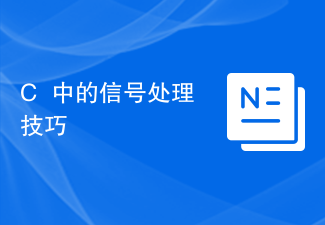
如何解決C 大數據開發中的資料安全傳輸問題?
#隨著大數據的快速發展,資料安全傳輸成為了開發過程中不可忽視的問題。在C 開發中,我們可以透過加密演算法和傳輸協定來確保資料在傳輸過程中的安全性。本文將介紹如何解決C 大數據開發中的資料安全傳輸問題,並提供範例程式碼。
一、資料加密演算法
C 提供了豐富的加密演算法庫,如OpenSSL、Crypto 等。這些庫可以用於對資料進行加密和解密操作。在大數據傳輸中,常用的加密演算法有DES、AES等。下面是一個使用AES加密演算法對資料進行加解密的範例程式碼。
#include <iostream>
#include <string>
#include <openssl/aes.h>
std::string Encrypt(const std::string& data, const std::string& key) {
std::string encryptedData;
AES_KEY aesKey;
AES_set_encrypt_key((const unsigned char*)key.c_str(), 128, &aesKey);
int dataSize = data.size();
int paddedDataSize = ((dataSize / AES_BLOCK_SIZE) + 1) * AES_BLOCK_SIZE;
unsigned char* inputData = new unsigned char[paddedDataSize];
memset(inputData, 0, paddedDataSize);
memcpy(inputData, data.c_str(), dataSize);
unsigned char* encryptedDataPtr = new unsigned char[paddedDataSize];
AES_encrypt(inputData, encryptedDataPtr, &aesKey);
encryptedData.assign((char*)encryptedDataPtr, paddedDataSize);
delete[] inputData;
delete[] encryptedDataPtr;
return encryptedData;
}
std::string Decrypt(const std::string& encryptedData, const std::string& key) {
std::string decryptedData;
AES_KEY aesKey;
AES_set_decrypt_key((const unsigned char*)key.c_str(), 128, &aesKey);
int dataSize = encryptedData.size();
unsigned char* inputData = new unsigned char[dataSize];
memcpy(inputData, encryptedData.c_str(), dataSize);
unsigned char* decryptedDataPtr = new unsigned char[dataSize];
AES_decrypt(inputData, decryptedDataPtr, &aesKey);
decryptedData.assign((char*)decryptedDataPtr, dataSize);
delete[] inputData;
delete[] decryptedDataPtr;
return decryptedData;
}
int main() {
std::string data = "Hello, world!";
std::string key = "secretpassword";
std::string encryptedData = Encrypt(data, key);
std::cout << "Encrypted data: " << encryptedData << std::endl;
std::string decryptedData = Decrypt(encryptedData, key);
std::cout << "Decrypted data: " << decryptedData << std::endl;
return 0;
}二、資料傳輸協定
在C 中,我們可以使用SSL/TLS來確保資料在傳輸過程中的安全性。 SSL/TLS是一種常用的加密協議,可以透過憑證和金鑰來驗證和加密通訊。下面是一個使用boost.asio函式庫進行SSL/TLS通訊的範例程式碼。
#include <iostream>
#include <string>
#include <boost/asio.hpp>
#include <boost/asio/ssl.hpp>
void HandleMessage(const boost::system::error_code& error, std::size_t bytes_transferred) {
if (!error) {
std::string message(boost::asio::buffer_cast<const char*>(buffer.data()), bytes_transferred);
std::cout << "Received message: " << message << std::endl;
}
}
int main() {
boost::asio::io_context ioContext;
boost::asio::ssl::context sslContext(boost::asio::ssl::context::sslv23);
sslContext.load_verify_file("ca.pem");
boost::asio::ssl::stream<boost::asio::ip::tcp::socket> sslSocket(ioContext, sslContext);
boost::asio::ip::tcp::resolver resolver(ioContext);
boost::asio::ip::tcp::resolver::results_type endpoints = resolver.resolve("www.example.com", "https");
boost::asio::ip::tcp::endpoint endpoint = *endpoints.begin();
sslSocket.lowest_layer().connect(endpoint);
sslSocket.handshake(boost::asio::ssl::stream_base::handshake_type::client);
std::string message = "Hello, server!";
boost::asio::write(sslSocket, boost::asio::buffer(message));
boost::asio::streambuf response;
boost::asio::async_read(sslSocket, response, HandleMessage);
ioContext.run();
return 0;
}三、綜合應用範例
以下是一個綜合應用範例,示範如何在C 大數據開發中確保資料安全傳輸。
#include <iostream>
#include <string>
#include <openssl/aes.h>
#include <boost/asio.hpp>
#include <boost/asio/ssl.hpp>
std::string Encrypt(const std::string& data, const std::string& key) {
// 加密算法代码
}
std::string Decrypt(const std::string& encryptedData, const std::string& key) {
// 解密算法代码
}
void HandleMessage(const boost::system::error_code& error, std::size_t bytes_transferred) {
if (!error) {
std::string message(boost::asio::buffer_cast<const char*>(buffer.data()), bytes_transferred);
std::cout << "Received message: " << message << std::endl;
std::string decryptedMessage = Decrypt(message, "secretpassword");
std::cout << "Decrypted message: " << decryptedMessage << std::endl;
}
}
int main() {
std::string data = "Hello, world!";
std::string key = "secretpassword";
std::string encryptedData = Encrypt(data, key);
std::cout << "Encrypted data: " << encryptedData << std::endl;
std::string decryptedData = Decrypt(encryptedData, key);
std::cout << "Decrypted data: " << decryptedData << std::endl;
boost::asio::io_context ioContext;
boost::asio::ssl::context sslContext(boost::asio::ssl::context::sslv23);
sslContext.load_verify_file("ca.pem");
boost::asio::ssl::stream<boost::asio::ip::tcp::socket> sslSocket(ioContext, sslContext);
boost::asio::ip::tcp::resolver resolver(ioContext);
boost::asio::ip::tcp::resolver::results_type endpoints = resolver.resolve("www.example.com", "https");
boost::asio::ip::tcp::endpoint endpoint = *endpoints.begin();
sslSocket.lowest_layer().connect(endpoint);
sslSocket.handshake(boost::asio::ssl::stream_base::handshake_type::client);
boost::asio::write(sslSocket, boost::asio::buffer(encryptedData));
boost::asio::streambuf response;
boost::asio::async_read(sslSocket, response, HandleMessage);
ioContext.run();
return 0;
}在本文中,我們介紹如何解決C 大數據開發中的資料安全傳輸問題。透過加密演算法和傳輸協議,可以保證資料的機密性和完整性。範例程式碼演示了使用AES加密演算法和SSL/TLS協定進行資料的加密和傳輸。根據實際情況,可以進行相應的修改和擴展,以滿足不同的需求。
以上是如何解決C++大數據開發中的資料安全傳輸問題?的詳細內容。更多資訊請關注PHP中文網其他相關文章!
 Windows 11 系统下的五款最佳免费 C++ 编译器推荐Apr 23, 2023 am 08:52 AM
Windows 11 系统下的五款最佳免费 C++ 编译器推荐Apr 23, 2023 am 08:52 AMC++是一种广泛使用的面向对象的计算机编程语言,它支持您与之交互的大多数应用程序和网站。你需要编译器和集成开发环境来开发C++应用程序,既然你在这里,我猜你正在寻找一个。我们将在本文中介绍一些适用于Windows11的C++编译器的主要推荐。许多审查的编译器将主要用于C++,但也有许多通用编译器您可能想尝试。MinGW可以在Windows11上运行吗?在本文中,我们没有将MinGW作为独立编译器进行讨论,但如果讨论了某些IDE中的功能,并且是DevC++编译器的首选
 C++报错:变量未初始化,应该如何解决?Aug 21, 2023 pm 10:01 PM
C++报错:变量未初始化,应该如何解决?Aug 21, 2023 pm 10:01 PM在C++程序开发中,当我们声明了一个变量但是没有对其进行初始化,就会出现“变量未初始化”的报错。这种报错经常会让人感到很困惑和无从下手,因为这种错误并不像其他常见的语法错误那样具体,也不会给出特定的代码行数或者错误类型。因此,下面我们将详细介绍变量未初始化的问题,以及如何解决这个报错。一、什么是变量未初始化错误?变量未初始化是指在程序中声明了一个变量但是没有
 C++编译错误:未定义的引用,该怎么解决?Aug 21, 2023 pm 08:52 PM
C++编译错误:未定义的引用,该怎么解决?Aug 21, 2023 pm 08:52 PMC++是一门广受欢迎的编程语言,但是在使用过程中,经常会出现“未定义的引用”这个编译错误,给程序的开发带来了诸多麻烦。本篇文章将从出错原因和解决方法两个方面,探讨“未定义的引用”错误的解决方法。一、出错原因C++编译器在编译一个源文件时,会将它分为两个阶段:编译阶段和链接阶段。编译阶段将源文件中的源码转换为汇编代码,而链接阶段将不同的源文件合并为一个可执行文
 如何优化C++开发中的文件读写性能Aug 21, 2023 pm 10:13 PM
如何优化C++开发中的文件读写性能Aug 21, 2023 pm 10:13 PM如何优化C++开发中的文件读写性能在C++开发过程中,文件的读写操作是常见的任务之一。然而,由于文件读写是磁盘IO操作,相对于内存IO操作来说会更为耗时。为了提高程序的性能,我们需要优化文件读写操作。本文将介绍一些常见的优化技巧和建议,帮助开发者在C++文件读写过程中提高性能。使用合适的文件读写方式在C++中,文件读写可以通过多种方式实现,如C风格的文件IO
 C++编译错误:无法为类模板找到实例化,应该怎么解决?Aug 21, 2023 pm 08:33 PM
C++编译错误:无法为类模板找到实例化,应该怎么解决?Aug 21, 2023 pm 08:33 PMC++是一门强大的编程语言,它支持使用类模板来实现代码的复用,提高开发效率。但是在使用类模板时,可能会遭遇编译错误,其中一个比较常见的错误是“无法为类模板找到实例化”(error:cannotfindinstantiationofclasstemplate)。本文将介绍这个问题的原因以及如何解决。问题描述在使用类模板时,有时会遇到以下错误信息:e
 iostream头文件的作用是什么Mar 25, 2021 pm 03:45 PM
iostream头文件的作用是什么Mar 25, 2021 pm 03:45 PMiostream头文件包含了操作输入输出流的方法,比如读取一个文件,以流的方式读取;其作用是:让初学者有一个方便的命令行输入输出试验环境。iostream的设计初衷是提供一个可扩展的类型安全的IO机制。
 c++数组怎么初始化Oct 15, 2021 pm 02:09 PM
c++数组怎么初始化Oct 15, 2021 pm 02:09 PMc++初始化数组的方法:1、先定义数组再给数组赋值,语法“数据类型 数组名[length];数组名[下标]=值;”;2、定义数组时初始化数组,语法“数据类型 数组名[length]=[值列表]”。
 C++中的信号处理技巧Aug 21, 2023 pm 10:01 PM
C++中的信号处理技巧Aug 21, 2023 pm 10:01 PMC++是一种流行的编程语言,它强大而灵活,适用于各种应用程序开发。在使用C++开发应用程序时,经常需要处理各种信号。本文将介绍C++中的信号处理技巧,以帮助开发人员更好地掌握这一方面。一、信号处理的基本概念信号是一种软件中断,用于通知应用程序内部或外部事件。当特定事件发生时,操作系统会向应用程序发送信号,应用程序可以选择忽略或响应此信号。在C++中,信号可以


熱AI工具

Undresser.AI Undress
人工智慧驅動的應用程序,用於創建逼真的裸體照片

AI Clothes Remover
用於從照片中去除衣服的線上人工智慧工具。

Undress AI Tool
免費脫衣圖片

Clothoff.io
AI脫衣器

AI Hentai Generator
免費產生 AI 無盡。

熱門文章

熱工具

Safe Exam Browser
Safe Exam Browser是一個安全的瀏覽器環境,安全地進行線上考試。該軟體將任何電腦變成一個安全的工作站。它控制對任何實用工具的訪問,並防止學生使用未經授權的資源。

SublimeText3 Linux新版
SublimeText3 Linux最新版

SublimeText3漢化版
中文版,非常好用

記事本++7.3.1
好用且免費的程式碼編輯器

SublimeText3 Mac版
神級程式碼編輯軟體(SublimeText3)





